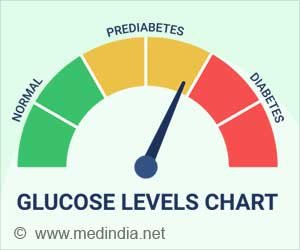Don’t Wait, Act Now! Reverse Prediabetes

Unfortunately, the conversion from prediabetes to diabetes occurs more rapidly in the Indian population than in any other group, with approximately 15.3 percent of Indians already in the prediabetes stage (
).
Prediabetes can be identified through fasting blood glucose levels. A fasting blood glucose below 100 is considered normal. If the levels range between 101 and 125, it indicates a form of prediabetes known as impaired fasting glucose (IFG). A fasting blood glucose level above 126 signifies the progression of diabetes (
).
Another type of prediabetes is impaired glucose tolerance (IGT). To diagnose IGT, a glucose tolerance test is conducted. Participants consume 75 grams of glucose powder dissolved in water after fasting, and blood is drawn exactly two hours later.
Advertisement
A blood glucose level below 140 indicates normalcy. Readings between 140 and 199 indicate IGT, while a reading above 200 is an indicator of diabetes. Some individuals may have only IFG or IGT, while others may have both simultaneously. It is important to be aware of these distinctions because having one or both types of prediabetes increases the risk of progressing to full-fledged diabetes at a faster rate.
Symptoms of Prediabetes
Unfortunately, prediabetes does not exhibit any symptoms. Symptoms like increased thirst and frequent urination typically manifest in the advanced stages of diabetes, not during the prediabetes phase.
Detection and Screening of Prediabetes
In India, it is ideal to screen all adults for prediabetes. A recent study conducted in collaboration with the Indian Council of Medical Research (ICMR) revealed that 15.3 percent of the population, equivalent to 136 million people, are prediabetic and at risk of developing diabetes.
Approximately 30 to 50 percent of individuals with prediabetes progress to diabetes, while some remain prediabetic and a few manage to reverse their condition. Those in the early stages of prediabetes may be able to return to normal by losing weight. However, failure to take action may lead to weight gain and the progression of diabetes. Indians have a higher tendency to develop diabetes from prediabetes compared to Caucasians, who take five to ten years longer to reach the same stage.
Recognizing the Importance of Prediabetes and Taking Action
To identify individuals at risk of prediabetes, a cost-effective method has been developed called the Indian Diabetes Risk Score Test. This test is the culmination of 20 years of research. It involves asking three questions and measuring the individual’s waistline with the tailor’s tape.
The questions focus on age, family history of diabetes, and physical activity. Scoring is determined based on the answers provided. Physical activity is classified as no activity, light activity, or vigorous activity.
Additionally, the waistline measurement is taken at the umbilicus. Based on the collected scores, with a maximum of 100 and a minimum of zero, a combined score above 60 indicates a high risk of developing diabetes. This simple risk score enables the identification of the 12 to 15 percent of the population at risk of prediabetes.
Actions to Take After Diagnosis of Prediabetes
Weight reduction is crucial for individuals diagnosed with prediabetes, as excess weight is common among them.
Even a moderate weight loss of 5 to 10 kilograms can reverse prediabetes. However, the weight loss must be consistent, and efforts should be made to prevent its return. Here are some recommendations:
Calorie Reduction
: Cut calorie intake in half, reducing it from 2,400 calories to a lower amount. Since most weight comes from carbohydrates, decrease wheat and rice consumption by 50 percent. Opt for complex carbohydrates and replace them with green leafy vegetables, proteins, fruits, Bengal grams, mushrooms, or plant proteins to facilitate weight loss over time.
Exercise
: Engage in approximately 45 minutes of brisk walking, jogging, cycling, dancing, swimming, aerobic exercises, or resistance training. Choose activities that you enjoy and can sustain in the long run.
Maintain Regular Sleep Timing
: Disruption of the body’s circadian rhythm can contribute to obesity. Aim to sleep by 11 pm if possible.
Manage Stress
: Reduce stress levels through deep breathing exercises and relaxation techniques.
It is recommended to undergo a comprehensive health check-up, including key markers of your body, after the age of 35. Do not underestimate the importance of basic tests, as they can help identify potential health issues early on. After the tests, consult a healthcare professional rather than relying on non-medical professionals for lifestyle management. A sustainable pattern of reversal must be established. Prediabetes serves as an early warning signal, and once you understand your position on the risk scale, it is up to you to reclaim your health and well-being.
References :
- Epidemiology of diabetes and diabetes-related complications – (https://pubmed.ncbi.nlm.nih.gov/18801858/)
- Diabetes Tests – (https://www.cdc.gov/diabetes/basics/getting-tested.html)
Source: Medindia
Source link
#Dont #Wait #Act #Reverse #Prediabetes



